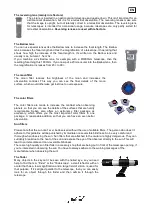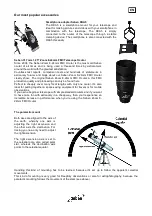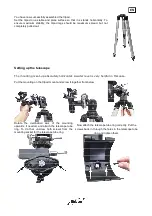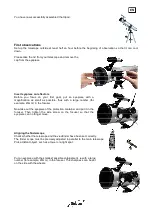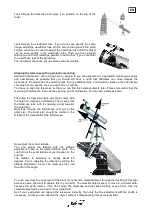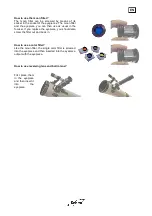
EN
The reversing lens (mainly in reflectors)
The picture is inverted in an astronomical telescope and upside down. This isn’t important for an
astronomical observation, but it is for a terrestrial observation. The reversing lenses make sure
that the image is upright, but not laterally correct in a terrestrial observation. The reversing lens
for telescopes is intended for occasional usage, because telescopes are only partly suited for
terrestrial observations. Reversing lenses are used with reflectors.
The Barlow lens
You can use special lenses like the Barlow lens to increase the focal length. The Barlow
lens increases the focal length and thus the magnification of a telescope. It has rating that
shows how high the increase of the focal length is. It’s written on the Barlow lens and
usually is 2x, but also 1.5x or 3x.
If you combine a 2x Barlow lens, for example, with a 60/900mm telescope, then the
resulting focal length is 1800mm. If you now put a 20mm-ocular into the Barlow lens, then
the magnification increases from 45× to 90×.
The moonfilter
The moon filter reduces the brightness of the moon and increases the
observation contrast. This way you can see the finer details of the moon
surface, which would otherwise get lost due to overexposure.
The color filters
The color filters are made to increase the contrast when observing
planets, so that you can see the details of the surfaces that are hardly
recognizable. Seben also offers an astronomy filter package as
accessory, which offers you the most important color filters in one
package. A reasonable addition, so that you can have an even better
observation.
Sun filters
Please note that the sun can’t ever be observed without the use of suitable filters. The person who doesn’t
adhere to this guideline will be punished by immediate non-reversible blindness. So be very careful and
thorough when observing the sun. Sun filters that are attached to the ocular are highly dangerous. They can
suddenly break due to the heat of the sun and expose the eye of the observer directly to the sun. This will
lead to an immediate and non-reversible blindness.
There are high quality sun filter foils in accessory shop that are being put in front of the telescope opening, if
you’re interested in observing the sun You have to always adhere to the warning messages of the
manufacturer when observing the sun!
The finder
Many objects in the sky can’t be seen with the naked eye, so you need
help to find them. A “finder” or the “finderscope”, a small refractor with an
ocular that has a low magnification and a large field of vision, is used for
that purpose. If it’s aligned parallel to the telescope, then you can easily
look for an object through the finder and then admire it through the
telescope.




